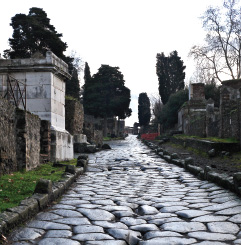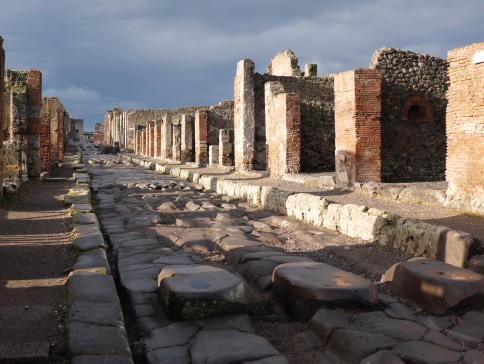![]()
WHEN he described the catastrophic eruption of Mount Vesuvius on 24 August AD 79, the elder Pliny had no notion that this would actually preserve the fabric of so many of the buildings it overwhelmed. Pompeii, a significant town with a population of perhaps 20,000, was smothered by ashes: her smaller neighbour, Herculaneum, was entombed by the lava flow. The latter is the better preserved, but it is Pompeii, systematically excavated for the Bourbon kings, that captured the European imagination. It inspired the best known of Lord Lytton’s novels, The Last Days of Pompeii, and the most dramatic canvas of the greatest Russian Romantic painter, Alexandre Brullov – before which Sir Walter Scott sat for an hour in silent admiration.

Pompeii, road to the Porta Ercolano.
Stabian baths: stucco decoration.
The tourist is unlikely to find silence in the centre of Pompeii itself, even out of season. But then the town would not have been silent in its bustling heyday. Rather than follow a fixed route, it is best to wander, dodging the coach parties. While the public buildings deserve attention, what is exceptional about Pompeii is the number of private houses that survive. Guards will encourage you to visit those in their control, but after half a dozen interest can flag. It should, moreover, be remembered that many of the finer murals and the more significant finds are in the Museo Archeologico at Naples. The usual entrance is the Porta Marina to the south-west of the town, the gate nearest the forum, the centre of religious and civic life. Here are the impressive basilica, two temples and a covered market. Further east, off the Strada dell’Abbondanza, are the Stabian baths, with a striking section of stucco decoration and well-preserved interiors: nearby are the theatre and the smaller odeon. The very much larger amphitheatre is at the eastern angle of the walls. Built about 80 BC, this could sit 12,000: a mural now at Naples shows it in use. Beside the amphitheatre is the large palaestra, or gymnasium. Everywhere, one is conscious of the menacing cone of Vesuvius.
While one of the finest houses, that of Loreius Tiburtinus, notable for its garden, is opposite the palaestra, most are in the north-western section of the town, many off the Strada di Nola. Among the more interesting are the Casa del Poeta Tragica, described in Lytton’s novel, and the Casa del Fauno, with two atriums and two peristyles; from a room between these comes the mosaic of the Battle of Alexander at Naples. A block to the north are the Casa dei Vettii, a prosperous merchant’s ambitious residence, and the Casa degli Amorini Dorati, both with excellent decoration. Yet more memorable are the murals of the large Villa dei Misteri, which lies outside the walls to the north-west. The Dionysiac scenes in the Sala del Grande Dipinto, which dates from about the turn of the Christian era, represent a high point of Roman painting.
Although Roman decorative murals had been known – and copied – since the Renaissance, the discovery of a large number of such schemes had an enormous influence on the direction of taste in the neoclassical era. Others have been discovered since. Particularly fine are those of the villa of Oplontis, in the immediate shadow of Vesuvius, not far from Herculaneum. No single complex perhaps gives a better notion of the sophistication of the most luxurious Roman villas or of the world of the Plinys, uncle and nephew, and their friends. After its discovery the villa was impeccably restored, but on my last visit it looked rather run down, its state paralleling the plight of the numerous ville vesuviane of the Bourbon era, classical in very different terms, that disintegrate nearby.

characteristic street, with blocks to impede wheeled traffic.